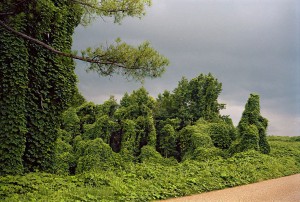
William Christenberry, "Kudzu with Storm Cloud, near Akron, Alabama," 1981.
“It is the common mission of the entire mankind to curb global warming and save our planet.” So said China’s Prime Minister, Wen Jiabao, addressing the Copenhagen Summit on December 18. Statements like these have become standard fare. Much of the talk about climate change and green living focuses on common missions and shared responsibility to nature. But, of course, what concerns us most is not preserving nature; it’s preserving ourselves. At times, all the biodegradable cups, energy saving strategies, and carbon emission mandates seem like sacrifices (sensible, worthwhile sacrifices, but sacrifices nonetheless) to the cosmos—a mysterious entity destined to outlast us, in one way or another, even if it changes beyond all recognition.
Eugene Von Bruenchenhein, detail, "Atomic Age," 1955. Oil on board. Courtesy Kinz, Tillou + Feigen, New York. Quote from Reverend Howard Finster's sermon cards.
Last year, the New Museum hosted a timely and much-hyped exhibition called After Nature. Presented as “a feverish examination of an extinct world that strangely resembles our own,” the exhibition was a melancholic attempt to face the fear that nature will eventually take over everything we create. A disillusioned romanticism characterized many of the show’s landscapes: Eugene Von Bruenchenhein’s Atomic Age depicted an ornate, reptilian volcano; Berlinde De Bruyckere’s Robin V depicted a frail body merging with brush. Peter Schjeldahl saw After Nature’s disillusionment as self-suffocating, writing in the New Yorker, “Desperate to eschew narcissisms of money and fame, along with academically entrenched ideology, the artists operate at psychological depths at which social attitudes can’t coalesce.”
At least one artist in After Nature managed to sidestep the malaise, however. William Christenberry, a veteran landscape photographer who grew up in pre-Civil Rights Alabama, leveled more common-sense observations at the crisis of nature in art. One of Christenberry’s contributions to the exhibit portrays an old building completely reclaimed by its surroundings. Christenberry has been visiting this building for years, and each photograph he makes of it has the same title: Building with False Brick Siding, Warsaw, Alabama. In the first photograph, taken in 1974, the false brick is fully visible, though the house certainly doesn’t look lived in and the siding has begun to peel off up near the roof. The vines growing up the right corner of the house seem almost tasteful, like green accents.
William Christenberry, "Building with False Brick Siding, Warsaw, Alabama (1974)."
William Christenberry, "Building with False Brick Siding, Warsaw, Alabama (1982)."
Eight years later, in 1982, when Christenberry re-photographed the house (this print appeared in After Nature), nearly the whole building had been shrouded in green. The image’s title started to seem like a joke, since only a smidgen of the faux brick could be seen poking out above the porch. By 1991, the vines had been removed, but trees and brush had grown out of control, obstructing any path to the house’s entrance.
William Christenberry, "Building with False Brick Siding, Warsaw, Alabama (1991)."
By 1994, the building could hardly be made out. Its structure, and its siding, had completely vanished into the growth of green. The title no longer made any sense.
But Christenberry’s project does make sense. He’s documenting a process we’re already intuitively familiar with (ashes to ashes, dust to dust, right?), and the frankness of his images tell us more than any mythic, apocalyptic portrayals of natural disintegration could.
William Christenberry, "Building with False Brick Siding, Warsaw, Alabama (1994)."